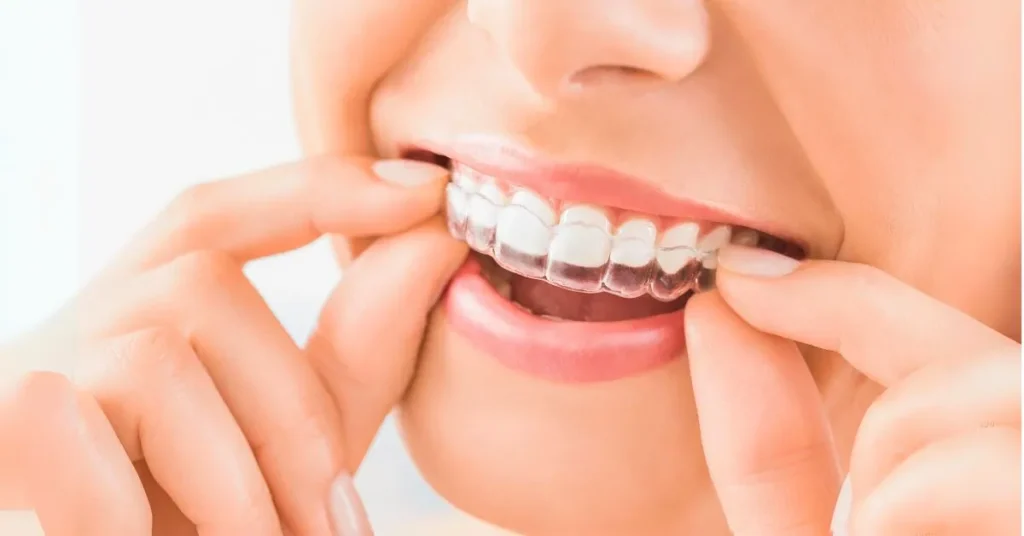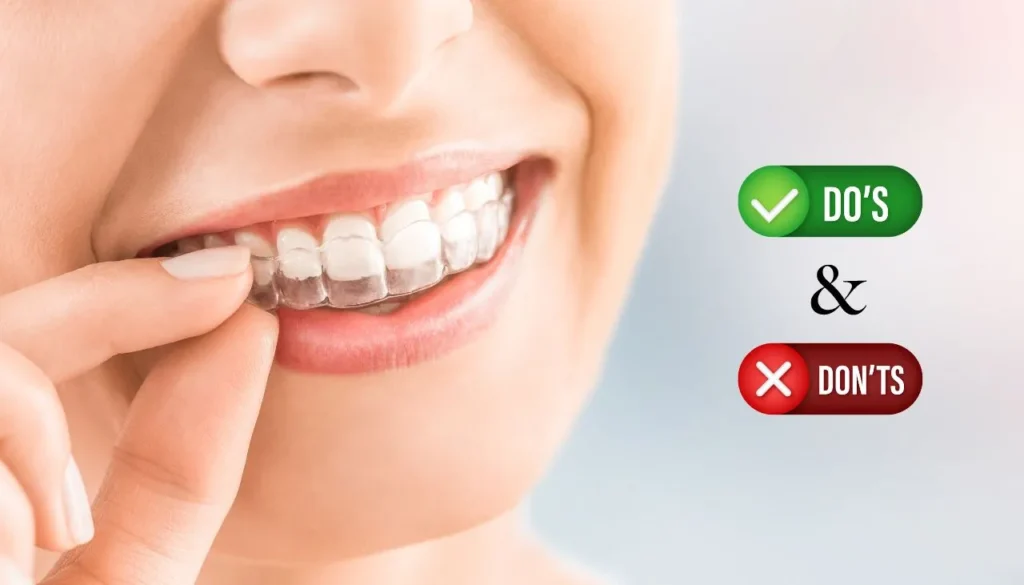An open bite is when the upper jaw teeth and lower jaw teeth do not meet and a gap appears in between. It is a type of malocclusion or malalignment of the teeth. Fixing an open bite is important since it can affect your speech, sleep, chewing food, and the general wear and tear of your teeth.
There are two types of open bite: anterior and posterior. Anterior is more common than posterior.
Anterior Open Bite: An anterior open bite is when a person’s upper and lower front teeth; do not touch when biting down.
Posterior: There is an opening between the back teeth whereas the front teeth can close when biting down.
Causes of Open Bite
These factors may cause open bite:
Thumb or pacifier sucking:
In childhood, if someone sucks on their thumb or a pacifier (or sucks another foreign object like a pencil), they strain the alignment of their teeth. This can cause an open bite.
Genetics:
In some cases, genetics can play a significant role in the development of open bites. If other family members have had open bites, there may be a chance of genetic tendency.
Tongue thrusting:
An open bite can occur when a person speaks or swallows and pushes their tongue between their upper and lower front teeth. This can also create gaps between teeth.
Temporomandibular Joint Disorder (TMD or TMJ):
Such disorders cause chronic jaw pain. Sometimes, people use their tongue to push their teeth apart and comfortably reposition their jaw, which can cause an open bite.
Skeletal problem:
Skeletal problems occur when your jaws grow apart instead of growing parallel to each other, and they are often influenced by genetics.
Dental open bite:
The Dental Open Bite happens when a tooth is unable to erupt enough to pass through the jawbone and gum.
Open Bite Symptoms: Potential Risks
Difficulty in chewing and eating:
An open bite can prevent you from properly biting and chewing food. The situation can be worse especially if you have a posterior open bite. This can affect their ability to enjoy a wide range of foods and may lead to dietary limitations.
Speech impairment:
An open bite can interfere with speech clarity affecting some pronunciation as many people with open bite develop a lisp. This can affect their self-confidence and communication skills.
Increased risk of tooth wear and gum problems:
Improper tooth alignment in open bite cases can increase the risk of dental problems. These include tooth decay, gum problems, and even temporomandibular joint (TMJ) issues due to the abnormal forces placed on the jaw joints during chewing and speaking.
Psychological impacts:
The person with an open bite may find it difficult to perform his day-to-day activities like attending classes in school or college or communicating with a larger audience due to his dental flaw which drives attention towards his mouth. Also, the speech impairment of such people may affect their self-esteem.
Effects on sleep:
An open bite can lead to discomfort and pain in the jaw and surrounding muscles, making it challenging to find a comfortable sleeping position. Additionally, it may contribute to breathing difficulties during sleep, such as snoring or sleep apnea, due to misalignment of the teeth and jaw that obstructs the airway, resulting in interrupted breathing patterns. Chronic sleep disturbances caused by an open bite can elevate the risk of developing sleep disorders like insomnia or sleep apnea, impacting both sleep quality and overall health, as well as daytime functioning.
Diagnosis of Open Bite
Diagnosing an open bite involves a comprehensive evaluation by experienced orthodontists. The diagnostic process includes the following steps:
Clinical examination:
During the consultation and examination session, the orthodontist will assess the alignment of your teeth and the connection between your upper and lower jaws. They will examine your bite in both static and dynamic positions. This examination helps identify the presence of an open bite and its severity.
Medical and dental history:
Your orthodontist will inquire about your medical and dental history, including any habits or conditions that might contribute to the open bite.
X-rays and imaging:
X-rays and images may be taken to provide a detailed view of the teeth and jaw structures. These will help the orthodontist evaluate the underlying bone structure and identify any issues not visible during the clinical examination.
Photographs:
Photographs of your face and smile from various angles may be taken to document the current condition and serve as a reference throughout treatment.
Dental impressions:
In some cases, dental impressions or digital scans of your teeth may be taken to create models of your bite. These models can help the orthodontist plan and visualize the necessary treatment.
Once the orthodontist has gathered all the necessary information, they will provide a diagnosis and discuss treatment options with you. The severity of the open bite and other factors, such as your age and overall oral health, will influence the recommended treatment plan.
Treatment Options for Open Bite
There are severe treatment options available these days to treat open bites that vastly depend on the patient’s condition, age and other factors.
Braces:
Traditional braces can be highly effective in treating open bites. They consist of brackets attached to the teeth and connected by arch wires. By applying gentle pressure over time, braces gradually move the teeth into the correct position to close the open bite.
Clear aligners:
Clear aligners are an attractive option for patients seeking a more discreet treatment. These custom-made, removable aligners gradually shift the teeth into alignment over a while. They are virtually invisible and can be removed for eating, brushing, and flossing.
Orthognathic surgery (jaw surgery):
In severe cases of open bites, surgical correction may be necessary. Orthognathic surgery, performed by an oral and maxillofacial surgeon, can reposition the upper or lower jaw to achieve proper alignment. This surgical approach is typically reserved for adult patients.
Dental appliances:
Orthodontic appliances other than braces are usually recommended for children. These appliances, such as bite blocks or palatal expanders, can help guide the child’s jaw growth and encourage the proper alignment of teeth.
Myofunctional therapy:
Myofunctional therapy is beneficial in open bites. In this approach, abnormal habits are corrected, and the tonicity of the oral muscles is improved, which in turn allows lip competence.
Combinations of treatments:
A combination of two or more approaches, such as orthodontic devices and other therapies, can be beneficial in some cases.
Prevention and Management
- Early intervention and treatment: Timely diagnosis and treatment can help address open bites effectively and improve oral health and overall well-being.
- Lifestyle Modifications and Prevention: Avoiding certain habits like teeth grinding and maintaining oral health help prevent open bites.
- Breaking habits: If an open bite is related to habits like thumb-sucking or tongue-thrusting, behavior modification techniques and appliance may be used, often in combination with orthodontic treatment.
- Proper oral hygiene and dental care: Golden rule of brushing, flossing and using mouthwash.
- Retainers after treatment: After the active phase of treatment, retention is crucial to maintain the results. Retainers, which can be fixed or removable, help keep the teeth in their corrected positions.
- Regular dental check-ups: Regular check-ups with your orthodontist at your trusted dental clinic will ensure your speedy recovery.
How much does corrective treatment cost for open bite?
The treatment price of open bites in India may range between Rs 35,000-80,000 or above. It is essential to understand that the actual cost may vary for each individual based on various factors, such as case complexity, age, etc.
Tips for maintaining good oral hygiene habits
- Brush & floss your teeth: Maintain a habit of brushing and flossing twice a day on a regular basis. Always try to floss and rinse after you eat to avoid food particles that can be left behind.
- Use mouthwash: After brushing, rinsing with mouthwash can kill any leftover bacteria and promote oral hygiene.
- Avoid Tobacco: Tobacco, among many other negative effects, is also known to dry out your mouth. This goes for all forms of tobacco, including cigarettes, hookah, chewing tobacco and so on.
- Drink plenty of water: Staying hydrated helps maintain a steady saliva flow and prevents bad breath. Also, water can help wash away leftover food particles from your teeth, keeping them fresh for long.
- Keep your regular dental appointments: You should continue to visit your orthodontist to ensure your smile is as healthy as possible.
Final Verdict
An open bite is a dental condition that can impact both the aesthetics and functionality of your smile. It can even cause other discomforting symptoms as well.
It is important to note that the severity of symptoms can vary among individuals. Some may experience mild symptoms, while others may face more significant challenges. As discussed, maintaining proper oral hygiene and regular dental check-ups are essential throughout your orthodontic treatment. This commitment to oral health, combined with the exceptional care and support provided by your orthodontist sets a strong core for successful open bite correction.
Remember, regardless of the severity, seeking a professional orthodontic evaluation is advisable when open bite symptoms are present.
FAQs
If behaviors like thumb-sucking or mouth-breathing are addressed early enough in childhood, an open bite may correct itself. In the case of adults, this is a treatable condition under orthodontic supervision.
The open bite treatment is painful or painless, depending on the type of treatment. If the condition is treatable with braces or clear aligners, then this process is time-worthy and doesn’t involve any pain. If the condition requires surgery, then you may experience postoperative pain.
Depending on the seriousness of the condition, several treatment options are available for correcting open bites, including orthodontic devices, surgery, several therapies, etc.
Whenever you notice the signs and symptoms of open bites, you should consult your nearest dentist without wasting time.
The treatment time typically depends on the treatment procedure prescribed by your orthodontist.
References
(2019) Dental Press Journal of Orthodontics.
(January 2017) Journal of Oral Health and Craniofacial Science 3(1):011-020.
(January 2018) J Oral Health Craniofac Sci. 2018; 3: 011-020.

